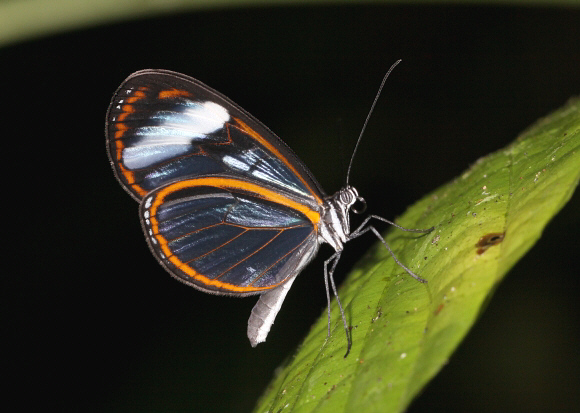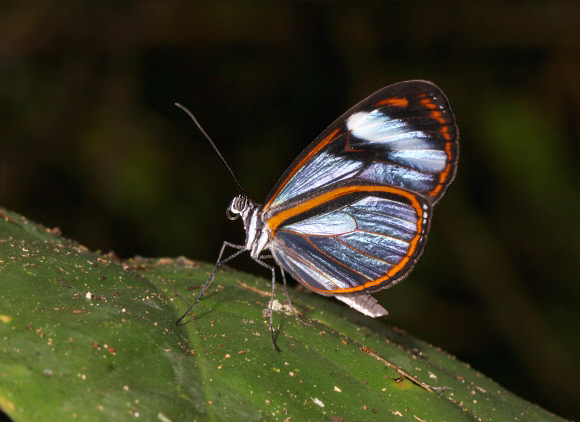
Introduction
The Ithomiini comprises of 376 known species, although it is likely that at least another 30 will be discovered in the near future. All are confined to the neotropical region. Ithomiines are unpalatable to birds, and are consequently mimicked in appearance by many other species. These include other unpalatable species ( Müllerian mimics ), not only from the Ithomiinae but also from several other butterfly families. There are also a large number of edible species ( Batesian mimics ) which have evolved similar patterns. Birds have the ability to memorise butterfly patterns and so learn to avoid eating noxious species, but are also fooled into ignoring similarly marked edible species.
Ithomiines are characterised by having small eyes, slender abdomens and long drooping antennae that lack distinct clubs. Males have a plume of long androconial scales or “hair pencils” on the costa of their hindwings. These are hidden from view when the butterflies are at rest, but are displayed when the wings are held open during courtship. Other Ithomiine characteristics include a very slow and deep wing beat, and a preference for inhabiting the darkest recesses of the forest understorey.
There are basically 2 types of Ithomiine. The first type are the black and orange-banded “tigers”, many of which are mimicked by other species due to their unpalatability to birds. The second type are the “glasswings”, recognised by their transparent or translucent wings, prominent veins, and orange wing margins. Many genera contain examples of both of these types, and in some cases an individual species may produce adults of both forms according to location.
The genus Oleria comprises of about 50 known species, recognisable from the distinctive venation of the hindwings.
The butterflies are varied in their habitat requirements – most species occur in lowland rainforests, many others specialise in cloudforest habitats, and a few occur in deciduous forests.
Oleria alexina is found from Colombia to Peru and Brazil.
Habitats
This species is associated primarily with wet tropical rainforest habitats, and is most commonly found in shady damp areas in the vicinity of rivers or streams, at altitudes between 200-800m.
Lifecycle
In common with all other Ithomiines, females of Oleria alexina normally lay their eggs directly on the underside of leaves of their foodplants.
The eggs are white, oval, and laid singly, although several may be dotted about in close proximity by one or more females. The eggs hatch after about 3 days. When newly hatched the caterpillar is transparent. It consumes its egg shell before beginning to feed on the foodplant. After each moult it consumes its shed skin, leaving only the chitinous head capsule remaining. When fully grown it is grey with a yellow line along the length of the body on each side. It takes only about 12 days from hatching to being ready to pupate. The chrysalis is pale green with shiny metallic golden reflections. The abdominal segments are compressed, and there is a dorsal hump. The overall impression is of a small leaf dripping with rain. The butterfly emerges after about a week. The lifecycle from egg to adult takes about 3 weeks to complete, so in theory up to 17 generations could be produced annually. However during the dry season reproductive activity is minimal. During this period the adults aggregate with numerous other Ithomiine species in small pockets within the forest. In Brazil and Ecuador for example I have found several such aggregations along the beds of small dry streams, where as many as 100 Ithomiines of up to 10 different species could be found aestivating among the stilt-like rootlets of palms.
Adult behaviour
The adults are normally found in small “leks” of up to a dozen butterflies. The males fly very slowly and almost incessantly around the lek area, only pausing to settle for a moment here and there, at which time they slowly fan their wings, probably to aid dissemination of pheromones from the androconial “hairs” on their wings.
Males of most Oleria species visit Eupatorium, from which they acquire pyrrolizidine alkaloids which they pass to the females during copulation, and which is believed to be essential for the production of viable eggs.
Females visit various flowers for nectar and pollen – the latter may be essential in the production of eggs and the maintenance of ovaries, as has been demonstrated to be the case with Heliconiines. Females also receive proteins during sperm transfer.
Gravid females fly very slowly, periodically dipping down to investigate Solanum plants. Having found the foodplant they then spend 2 or 3 minutes testing it, using olfactory sensors on their legs, antennae and abdomens, to determine if it is the correct species on which to oviposit.
In common with most other Ithomiines, lateral and altitudinal migrations of Oleria species are triggered by seasonal changes in humidity.

